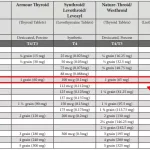
What’s Got Everyone Talking?
Let’s be honest. Thyroid meds don’t often make for dinner party talk… unless you’re someone who’s tried to explain to a friend how you can feel exhausted, anxious, and kind of “not yourself” even when the doc says your labs are “fine.” Sound familiar?
Here’s the surprise: Even with standard thyroid meds (like levothyroxine), about 1 in 5 folks still feel off. Yep, it’s real. That’s why so many people are chatting about natural options like NP Thyroid and Armour. These two cousins—both from pig thyroid glands, both packing that T3-T4 punch—are at the center of the NP Thyroid vs Armour conversion conversation. Today, we’re going beyond the label… Real talk, real experiences, real info. Buckle in.
So Wait, Why Switch?
Maybe you’re already on a thyroid med but still feel like your “get up and go” got up and left. Or you’re dealing with annoying side effects. Or you just heard about natural desiccated thyroid (NDT) and wonder if it’s worth a shot. That’s where NP Thyroid and Armour come into play—giving your body both T4 and T3 hormones, not just T4 like traditional drugs.
But… it’s not just about “natural is better.” There’s a reason these aren’t the #1 treatment for everyone. The punchline? They act a little more like our own thyroid… but doses can vary between batches, and sometimes brands have recalls (fun times, right?).
I’ll never forget my friend Jess, who after years of feeling gray on synthetics, switched to Armour—suddenly, she’s chasing her kids at the park like a superhero. But, it wasn’t all sunshine: she had to keep checking labs and sometimes those mood swings would sneak back in. That’s the rollercoaster.
How Are NP Thyroid and Armour Actually Different?
Sure, both are NDT (natural desiccated thyroid), but there are some little differences under the hood. NP Thyroid’s made by Acella and uses fewer inactive ingredients (just three fillers). Armour, from Allergan, has a slightly longer ingredient list. Both are taken as tablets, by prescription, and each “grain” of medicine contains about the same mix of T3 and T4.
Still, Both Are More “Natural” Than Synthetics…
But—big but!—they’re not identical to human thyroid. In pigs (fun fact), the T4:T3 ratio is about 4:1, while humans make more T4 than that. That means, sometimes, folks can get a bit too much T3 (hello, jitters!), or sometimes it’s just what your system’s been begging for.
Let’s Dig Into Dosage: The Art of NP Thyroid vs Armour Conversion
Feeling confused about swapping from Armour to NP Thyroid… or even from a synthetic option? You’re not alone. Everyone’s body handles these a little differently. It’s why there’s no perfect 1:1 swap—but there are charts and guides to give you a starting point.
How Do You Actually Convert?
Here’s the gist: Both NP Thyroid and Armour are measured in “grains.” One grain (about 60 mg, or 65 mg for some brands) contains roughly 38 mcg of T4 and 9 mcg of T3. For context, that’s pretty close to what you’d get in about 100 mcg of synthetic T4 (levothyroxine) or 25 mcg of synthetic T3 (liothyronine).
But—and there’s always a but—absorption is personal. Some people need less, others need more after a switch. Whenever you’re eyeing a switch, especially for NP Thyroid vs Armour conversion, your doc should recheck your thyroid labs every few weeks. TSH, T3, T4… the full alphabet soup.
Got Numbers? Here’s a Simple Comparison Table.
| NP Thyroid Dose | Armour Equivalent | Levothyroxine Approx. |
|---|---|---|
| 30 mg (1/2 grain) | 30 mg (1/2 grain) | 50 mcg |
| 60 mg (1 grain) | 60 mg (1 grain) | 100 mcg |
| 90 mg (1.5 grain) | 90 mg (1.5 grain) | 150 mcg |
| 120 mg (2 grains) | 120 mg (2 grains) | 200 mcg |
For more on exact matching, check out this NP thyroid vs Armour dosage guide. Just promise me you’ll use it as a starting point—everyone’s internal thermostat is, well, unique.
But What About Calculators?
Let’s be real. Unless you like number crunching (no judgment!), it helps to use a tool. That’s where a Thyroid conversion calculator comes in handy. You pop in your current dose, and it gives you a ballpark for another form. (Still, test and tweak with your doc on speed dial!)
Real Life: It’s Never Just About Numbers
When my aunt switched from Armour during that 2021 recall to NP Thyroid, we thought it would be as simple as matching grains. Newsflash: She got palpitations for the first week, so her doc cut back by half a tablet. Next lab test, everything settled. Moral? Always go slow, check levels, and journal your energy/mood.
T3, T4, and All That—What Does It Mean For You?
I get it. Hormones sound complicated, but here’s the simple version: T4 is the “storage” hormone. Your body turns it into T3, the “active” hormone. Synthetics like levothyroxine give you T4 only. Desiccated options (NP, Armour) deliver both—like a two-for-one sale, but without the coupon clipping.
Some people’s bodies struggle to convert T4 to T3, so getting both right off the bat can make a huge difference. On the flip side, too much T3 can make you feel wired, anxious, or throw your heart for a loop. It’s all about balance.
Curious Why You Might Still Feel Crummy on Levothyroxine?
Researchers suggest it might be because, for roughly 10-20% of us, our bodies aren’t that great at converting T4 to T3. Hence, getting both from your med can be a lightbulb moment. According to research on Armour Thyroid vs. levothyroxine, some folks just “feel better” on NDTs.
But, and I’m repeating this for the people in the back, more isn’t always better. If you switch, test regularly. Keep your endo in the loop.
What’s It Really Like To Switch?
Alright, you made it this far. Wondering if the grass truly is greener? Here’s the real talk on what happens when you do a NP Thyroid vs Armour conversion.
First, expect a few bumps. A couple weeks of jitters, tiredness, bathroom changes… your system is like “hey, new brand who dis?” Usually, these kinks work out in 2-3 weeks. Track your symptoms. Don’t be shy about logging how you feel each day, so you have more info to share at follow-ups.
Any Downsides?
Sure. Natural products aren’t FDA-approved like synthetic thyroid meds. That means quality and consistency can vary—not ideal if you like predictable results.
There’s also the ever-annoying problem of recalls (looking at you NP Thyroid, early 2020s). A shortage could mean you’re scrambling to find a new brand, which (honestly) is stressful. Armour’s been steadier in supply, but even it has had its moments.
Table Time: Pros & Cons at a Glance
| Aspect | NP Thyroid | Armour Thyroid |
|---|---|---|
| Inactive fillers | Only 3 (simple) | More (5+) |
| Availability | Occasional recalls/shortages | Usually steady |
| FDA approval | No | No |
| Price | Often lower | Comparable |
| Consistent potency | Varies more | Usually predictable |
Curious how your current dose might convert? Plug your numbers into this Thyroid conversion calculator for a quick result—and always show your work to your doc!
The Secret To Making A Switch That Actually Works
So, you’re ready to chat NP Thyroid vs Armour conversion with your doctor… What next? Here’s my biggest advice: don’t go it alone.
Bring along your NP thyroid vs Armour dosage notes, use that Thyroid conversion calculator, and talk over everything. Your doctor will probably check your labs in 4 to 6 weeks (yes, more poking). But that’s how you land on the dose that fits your body—not just the “typical” patient from a textbook.
One reader sent in a story last month—she switched from levothyroxine when her long walks left her feeling drained. With patience and a couple dose tweaks, she hit her stride again, literally and figuratively.
Add In Some Lifestyle
Don’t forget: No thyroid med works magic if your day-to-day is mayhem. Regular sleep, eating anti-inflammatory foods, moving your body (even gently)—they all play a role. If you do everything right and still feel blah, ask your doc about a switch.
Let’s Wrap: You’re Closer Than You Think
Changing thyroid meds isn’t about being trendy or caving into internet hype—it’s about your right to feel like yourself again. If NP Thyroid vs Armour conversion has been on your mind, know this: You’re not alone, it isn’t as scary as it sounds, and with a little detective work, you can really get closer to that daily “spark” again.
Just remember—every body is different. Some thrive on synthetics, others only wake up with a bit of T3 in the mix. Use your resources (yep, I’m shouting out that Thyroid conversion calculator again!), keep your doc in the loop, and don’t let one bad day shake your resolve.
Reflection time: Where are you in your thyroid journey? Are you thriving, surviving, or just getting by? Next step could be as simple as starting a conversation—with your doctor, or even just with yourself about how you really feel. You deserve to feel good, not just “okay.” Let’s keep moving toward vibrant, together.


















Leave a Reply
You must be logged in to post a comment.